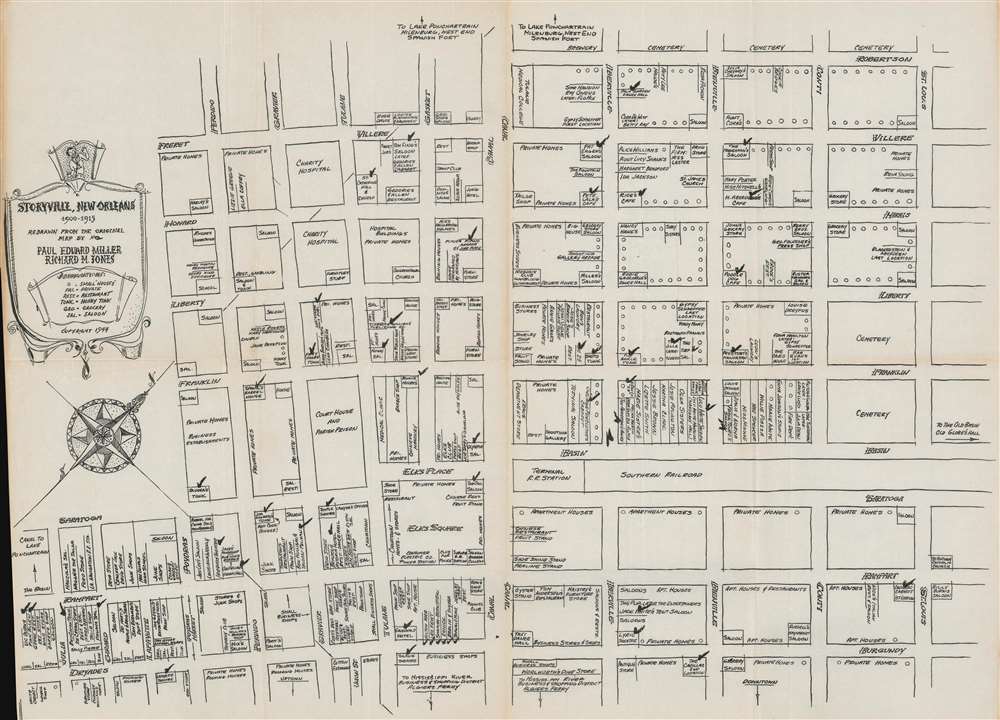This item has been sold, but you can get on the Waitlist to be notified if another example becomes available, or purchase a digital scan.
1944 Miller and Jones Map or Plan of Storyville, New Orleans (Red Light District)
Storyville-millerjones-1944
Title
1944 (dated) 17 x 23.5 in (43.18 x 59.69 cm)
Description
A Short History of Storyville
Storyville existed in New Orleans from 1897 until 1917, when it was disbanded by order of the Federal government in order to 'protect the morality' of American soldiers heading to France to fight in World War I. Storyville, originally called 'The District' got its nickname because City Alderman Sidney Story wrote the guidelines and legislation governing prostitution within the city. It was based on the red-light districts in northern German and Dutch ports with the goal of confining prostitution to one district which would make it easier for authorities to monitor and regulate. After it was disbanded, Storyville operated as an entertainment district in New Orleans throughout the 1920s in a more subdued style, although prostitution, gambling, and speakeasies were regularly found during police raids. Almost all the buildings in Storyville were demolished in the 1930s to build the Iberville Projects, a public housing project during the Great Depression.The Blue Book
So-called Storyville 'blue books', tourist guides, were published between 1895 and 1915 and by the early 1900s could be purchased for twenty-five cents. The books compiled the names of all the prostitutes working there (which were published in alphabetical order), landladies were identified in bold font, and the addresses of each were listed in a separate section. Interior and exterior pictures of the houses were included, but fees for services were not published.Publication History
This map was redrawn from the original by Paul Eduard Miller and Richard M. Jones and published in 1945 in Esquire's 1945 Jazz Book.CartographerS
Paul Eduard Miller (1902 - 1972) was a journalist and jazz critic. Miller began his writing career in the 1930s at Down Beat, and eventually rose to become one of its contributing editors. From 1939 Miller was also responsible for editing their jazz yearbook. Miller held the position of editor of an associated publication, Music and Rhythm, from November 1940 until August 1941, for which many Down Beat writers contributed. He served as the jazz editor for Esquire from 1944 until 1947 and edited their incredibly popular jazz yearbooks. He also published his own Yearbook of Popular Music in 1943. Miller hosted a radio show called 'This is Jazz' on WXRT-FM in Chicago on Friday and Saturday nights in the late 1940s and early 1950s. On a personal note, Miller had immense respect for Sidney Bechet, a New Orleans jazzman, whom he never missed an opportunity to praise in print and repeatedly named him to his all-star roster in Esquire's Jazz Book. He hosted Bechet for a series of concerts at Kimball Hall in Chicago in 1946 and 1947 and also hosted the musician at his home several times during the 1940s. Miller ambitious work The Best Jazz was never published. More by this mapmaker...
Richard M. Jones (June 13, 1892 - December 8, 1945), born Richard Marigny Jones, was an American jazz pianist, band leader, record producer, and composer. Born in New Orleans, Louisiana, Jones played alto horn in brass bands as a kid. Eventually, however, his main instrument became the piano. He was playing in Storyville, the red-light district of New Orleans, by 1908, and soon began leading his own band. He also worked in the bands of John Robichaux, Armand J. Piron, and Papa Celestin. Jones moved to Chicago in 1918, where he found work as the Chicago manager for Clarence Williams, a publisher and pianist. In 1923, Jones began recording, first as a solo pianist, then as an accompanist to vocalists and with his bands The Jazz Wizards and The Chicago Cosmopolitans. Throughout the rest of the 1920s, Jones recorded with Victor, Gennet, Okeh, and Paramount Records and worked as Chicago supervisor of Okeh Records 'Race' (African-American) Records for most of the 1920s. He held a similar management role for Decca Records in the 1930s and then moved on to Mercury Records until his death. Learn More...

